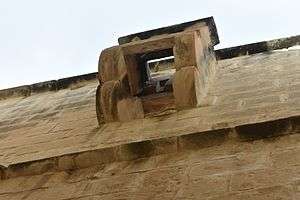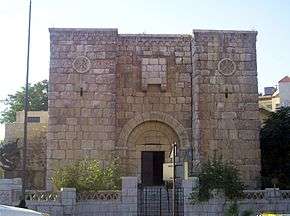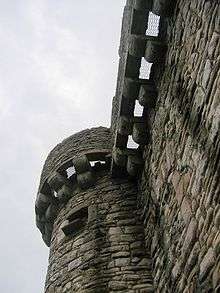Machicolation
A machicolation (French: mâchicoulis) is a floor opening between the supporting corbels of a battlement, through which stones or other material, such as boiling water or boiling cooking oil, could be dropped on attackers at the base of a defensive wall.[1] A smaller version found on smaller structures is called a box-machicolation.
| Machicolation | |
|---|---|
Mâchicoulis, Piombatoio | |
 A box-machicolation of the Tal-Wejter Tower, in Birkirkara, Malta | |
| General information | |
| Location | Europe, Middle East and North Africa |
| Technical details | |
| Material | Stone, sometimes wood |
Terminology

The structures are thought to have originated as Crusader imitations of mashrabiya.[2]
The word derives from the Old French word machecol, mentioned in Medieval Latin as machecollum, probably from Old French machier[3] 'crush', 'wound' and col 'neck'. Machicolate is only recorded in the 18th century in English, but a verb machicollāre is attested in Anglo-Latin.[4]
Both the Spanish and Portuguese words denoting this structure (matacán and mata-cães, respectively), are similarly composed from "matar canes" meaning roughly "killing dogs", the latter word being a slur referring to infidels.[5]
In Italy and countries which were influenced by the Italian language, such as Malta, it was known as piombatoio.[6]
Similar to a machicolation is a smaller version which opens similar to an enclosed balcony, generally from a tower rather than a larger structure. This is called a box-machicolation.[7]
Description and use
.png)

The design of a machicoulis (sometimes called drop box) originates from the Middle East, where they are usually found on defensive walls. The original Arabian design is rather small, and similar to the domestic wooden balcony known as mashrabiya.[8]
However, different from the domestic balcony, for defense purposes the Middle-East version of the machicoulis prominently features a wide opening at the bottom. The opening allows the dropping of hot water, oil and other material intended to cause harm to the enemy below. The otherwise enclosed opening adapted from that of a closed balcony also provides cover from enemy attack while using it.[8][9]
Machicolations were more common in French castles than English, where they were usually restricted to the gateway, as in the 13th-century Conwy Castle.[10] One of the first examples of machicolation that still exists in northern France is Château de Farcheville built in 1291 outside Paris.[11]
The origins are from Syria and the Crusaders brought their design to Europe.[12] Machicolations were a common feature in many towers in Rhodes, which were built by the Knights Hospitallers.[6] After the Knights were given rule over Malta, machicolations also became a common feature on rural buildings, until the 18th century. Buildings with machicolations include Cavalier Tower, Gauci Tower, the Captain's Tower, Birkirkara Tower and Tal-Wejter Tower.[7]
A hoarding is a similar structure made of wood, usually temporarily constructed in the event of a siege. Advantages of machicolations over wooden hoardings include the greater strength and fire resistance of stone.[13]
Post-medieval use
.jpg)
Machicolation was later used for decorative effect with spaces between the corbels but without the openings, and subsequently became a characteristic of many non-military buildings.[14][lower-alpha 1]
See also
- Arrow slit
- Bartizan
- Battlement
- Bretèche
- Defensive walls
- Jettying
- Murder hole
- Hoarding (castle)
Notes
- For example, Scottish baronial architecture from the 16th century onwards; and Neo-Gothic buildings of the 19th and 20th centuries.
References
- Jaccarini, C. J. (2002). "Il-Muxrabija: Wirt l-Izlam fil-Gzejjer Maltin" (PDF). L-Imnara (in Maltese). Ghaqda Maltija tal-Folklor. 7 (1): 17–22.
- Azzopardi, Joe (15 November 2015). "A survey of the Maltese Muxrabijiet" (PDF). Vigilo. DIN L‐ART ÓELWA (National Trust of Malta).
- Greimas (1987). A.-J; Dictionnaire de l’ancien français. Paris. ISBN 2-03-340-302-5.
- Hoad (1986) p. ?.
- Villena (1988) p. ?.
- Spiteri, Stephen C. (2008). "Naxxar and its Fortifications" (PDF). Arx - Online Journal of Military Architecture and Fortification (1–4): 13. Archived from the original (PDF) on 21 May 2017.
- Spiteri, Stephen C. (May 2008). "A Medieval tower at Qrendi?" (PDF). Arx - Online Journal of Military Architecture and Fortification (6): 59. Archived from the original (PDF) on 26 November 2016.
- Jaccarini, C. J. (2002). "Il-Muxrabija, wirt l-Iżlam fil-Gżejjer Maltin" (PDF). L-Imnara (in Maltese). Rivista tal-Għaqda Maltija tal-Folklor. 7 (1): 19. Archived from the original (PDF) on 18 April 2016.
- Azzopardi, Joe (April 2012). "A Survey of the Maltese Muxrabijiet" (PDF). Vigilo. Valletta: Din l-Art Ħelwa (41): 26–33. ISSN 1026-132X. Archived from the original (PDF) on 15 November 2015.
- Brown (2004), p. 66.
- Mesqui, Jean (1997). Châteaux forts et fortifications en France (in French). Paris: Flammarion. p. 493. ISBN 2-08-012271-1.
- Cathcart King, David James (1988). The Castle in England and Wales: an Interpretative History. London: Croom Helm. pp. 84–87. ISBN 0-918400-08-2.
- Toy, Sidney (2006). History of Fortification from 3000 BC to AD 1700. Pen and Sword. p. 103. ISBN 9781844153589.
- The Oxford Encyclopedia of Medieval Warfare and Military Technology. 1. Oxford University Press. 2010. p. 344. ISBN 9780195334036.
Bibliography
- Brown, R. Allen (2004) [1954]. Allen Brown's English Castles. Woodbridge: The Boydell Press. ISBN 1-84383-069-8.
- Hoad, T. F. (1986), English Etymology, Oxford University Press
- Villena, Leonardo (1988). "Sobre las defensas verticales en España: tipología y terminlogía comparadas". In Andrés Bazzana (ed.). Guerre, fortification et habitat dans le monde méditerranéen au Moyen Age: colloque. Casa de Velázquez. ISBN 978-84-86839-02-4.
External links
| Wikimedia Commons has media related to Machicolations. |
| Look up machicolation in Wiktionary, the free dictionary. |